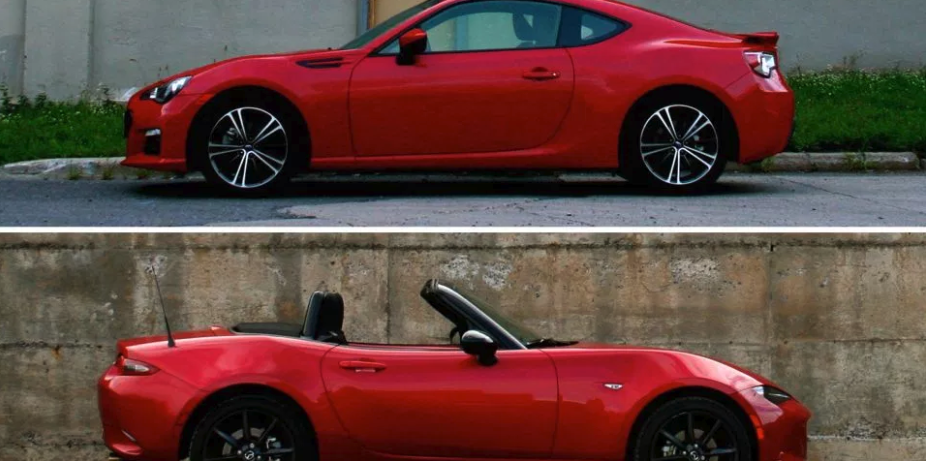Comparison Test: 2016 Mazda MX-5 vs. 2016 Subaru BRZ

Story and photos by John LeBlanc
Let’s call a spade a shovel: Affordable sports cars have always been a trendy segment, never an automotive staple.
The 1960s saw a wave of inexpensive British and Italian sports cars flood the market, while the 1990s were filled with cheap-and-fun Japanese models. But in between these blips, low-cost sports cars – the ones that can be enjoyed both on road and track – are normally an automotive anomaly.
Today, we are once again in an affordable sports car drought, limited to the 2016 Subaru BRZ (and its Scion FR-S twin) and the all-new 2016 Mazda MX-5. Between this rare pair, we asked: Which one offers the most definitive affordable sports car experience?
SECOND PLACE: 2016 Subaru BRZ
As a maker better known for its all-wheel-drive street-legal rally cars, Japan’s Subaru has zero heritage when it comes to affordable sports cars – which is why keen drivers on a budget were pleasantly surprised when the compact 2+2, rear-wheel-drive, two-door hardtop Subaru BRZ arrived for 2013.
Four models years on, the BRZ still offers a wealth of sports car driving experience for the price of a new mom-and-pop family sedan ($29,045, including freight and pre-delivery inspection fees).
For starters, to keep the BRZ’s centre of gravity as low as possible, the sports car uses a 2.0-litre Subaru flat-four cylinder engine. As a result, you’ll also sit closer to the ground in the BRZ than in the MX-5 – almost as if you are sitting in the Subie frame, instead of on it.
The BRZ only has 1,254 kilograms of curb weight to haul around, and its “Boxer” mill makes 200 horsepower and 151 lb.-ft. of torque. Accordingly, Subaru says the BRZ with the six-speed manual transmission takes 7.7 seconds to go from zero to 100 km/h (a $1,200 autobox is available, but puh-lease).
So it’s no rocket in a straight line. Still, your driver senses will scream “sports car” from the BRZ’s blatty-blat of its rorty exhaust and the positive nudges the short-throw gearbox asks for. Driven with verve on public roads, the Subaru offers quick, direct steering and an athletic – if firm-riding – chassis.
Compared to the MX-5, the BRZ’s body attitude in corners is much flatter – maybe too flat. With the electric nannies relaxed in VCS-Sport mode, the stability control system regularly jumps in to save the Subaru’s rear end from breaking loose.
Keep in mind, the BRZ’s lack of grip is intentional. In trying to recreate the zeitgeist of Japanese compact drift cars from the past, the Subaru wears Michelin Primacy tires from the fuel-economy-first Toyota Prius hybrid. Turn all the e-nannies off, and the BRZ will go sideways quicker than a politician running for re-election. Or understeer, if you like. Or whatever bent-out-of-shape form the driver (and their talent limits) is feeling up to.
As an affordable track car, the 2016 Subaru BRZ is beyond reproach. But for a sports car that can handle both the track and the road, read on.
FIRST PLACE: 2016 Mazda MX-5
As strange as it may sound to affordable sports car fans, since its debut for 1989, there were times when the existence of the MX-5 (let’s just call it a “Miata”) was called into question.
Yet as we watched many of the compact, rear-wheel-drive, two-seat, two-door convertible’s former customers migrate to more powerful and larger sports coupes, or – for shame! – crossovers and SUVs, Mazda has stayed true to the Miata’s original “light is right” design ethos with this latest, fourth-generation 2016 edition.
By some sort of engineering magic, Mazda’s engineers have been able to keep the $33,725 2016 Miata’s dimensions as close as possible to the tidy ’89 original – and notably smaller than the outgoing third-gen roadster.
Also crucial to any sports car’s overall performance, the Miata’s weight is kept down – an impressive 196 to 216 kilograms lighter than the hardtop BRZ, depending on the trim.
The lack of weight is important, mainly because the Miata’s 155-horsepower, 148 lb.-ft. 2.0-litre four-cylinder engine is down 12 horsepower from the last iteration. That said, the six-speed manual 2016 Miata is 0.5 quicker to 100 km/h than the BRZ and 0.3 second swifter than the 2015 version.
For buyers who will spend the majority of their time on public roads, Mazda’s Lotus-like lightweight approach to sports car design does not come at the sacrifice of its passengers.
Compared to the Subaru, the Mazda feels roomier inside. (And, of course, headroom immediately improves with the drop of its cloth top.) Plus, while the BRZ’s interior design is a nostalgic take on the 1990s, the new Miata feels much fresher, highlighted by its iPad-like central control screen.
Overall, the new Miata is easier to drive quickly than the BRZ. Changing from a hydraulic to an electric steering system makes the Mazda feel less edgy than the Subaru. There’s still plenty of off-centre feel, with feedback progressively increasing the tighter the turn.
And where the BRZ corners flat, the Miata’s body leans into corners, giving the impression that the sports car is better planted to the road. The Mazda’s stickier Bridgestone Potenza S001 tires definitely hang on longer than the slippier BRZ rubber. and when the Mazda eventually loses grip, it does so in a progressive, less abrupt nature.
Both of these affordable sports cars will put a smile on any driving enthusiast’s face. But the 2016 Mazda Mia-, er, MX-5 will create those smiles on a more regular basis.





![[del.icio.us]](https://www.straight-six.com/wp-content/plugins/bookmarkify/delicious.png)
![[Digg]](https://www.straight-six.com/wp-content/plugins/bookmarkify/digg.png)
![[Facebook]](https://www.straight-six.com/wp-content/plugins/bookmarkify/facebook.png)
![[Google]](https://www.straight-six.com/wp-content/plugins/bookmarkify/google.png)
![[Reddit]](https://www.straight-six.com/wp-content/plugins/bookmarkify/reddit.png)
![[StumbleUpon]](https://www.straight-six.com/wp-content/plugins/bookmarkify/stumbleupon.png)
![[Twitter]](https://www.straight-six.com/wp-content/plugins/bookmarkify/twitter.png)
![[Email]](https://www.straight-six.com/wp-content/plugins/bookmarkify/email.png)